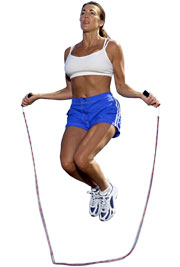Introduction to energy expenditure

Different types of food contain different amounts of energy. Fats and alcohol contain relatively high amounts of energy (i.e. 9 calories per gram in fat and 7 calories per gram in alcohol) compared to carbohydrates (3.75 calories per gram) and proteins (4 calories per gram). Thus the amount of energy consumed depends not only on the amount of food consumed, but also on the types of food consumed.
Energy produced from food in the human body is used to maintain the body’s essential functions (e.g. cell growth and repair, respiration, blood transport) and perform physical tasks including work, exercise and recreational activities. The body needs a set amount of energy just to perform its essential functions, and in most individuals, the majority of energy consumed will be expended performing these functions.
The vast majority of individuals also perform at least some form of physical activity throughout the day. Physical activity includes all forms of movement, including walking, lifting objects, cleaning, exercising and dancing. As the total amount of physical activity an individual performs increases, that individual’s energy requirement also increases.
The energy expended in performing physical tasks accounts for most of the individual’s remaining energy expenditure (after energy expended for essential functions). A range of factors including the types of physical activities performed, as well as the length of time for which they are performed, influence the amount of energy consumed.
What causes the body to burn calories?
There are many factors which affect the amount of energy an individual expends. Performing essential bodily functions and performing physical activities are the two major expenders of energy, although energy expenditure is also influenced by other factors such as age, gender and even menstruation.

The Basal Metabolic Rate (BMR) is the rate at which energy is expended for BEE while an individual is awake, but in a completely resting state (e.g. lying down and having not eaten, as eating increases energy expenditure because the body must expend energy to digest consumed food).
Physical activity and exercise
Apart from basal energy expenditure, an individual expends most of their energy performing a range physical activities, and Total Energy Expenditure (TEE) (i.e. basal energy expenditure plus all other energy expenditure) therefore depends largely on the amount of physical activity an individual performs. In individuals who perform a lot of physical activity (e.g. athletes, labourers), the component of energy consumed during physical activity is often more than the component expended performing essential bodily functions. Even in individuals who do not perform obviously physical tasks, physical activities which are performed unconsciously and spontaneously (e.g. fidgeting, smiling), consume energy.
Physical activity is the only factor influencing energy expenditure which can be controlled by an individual (as opposed, for example to gender and age). An individual who wished to increase their energy expenditure, therefore must increase either the quantity or vigour of physical activities they perform.
Physical activity is any activity which causes the body to move. Exercise is a distinct category of physical activity, characterised by activity which is sufficiently vigorous to induce laboured breathing and sweating. The amount of energy expended during a period of physical activity depends mainly upon the type of exercise and the vigour with which it is performed. More vigorous physical activities expend more energy, for example an individual who jogged for 30 minutes would expend more than an individual who walked for 30 minutes, as jogging is a more vigorous form of exercise.
The body weight of the individual performing the exercise also influences energy expenditure and, on average, heavier individuals will consume slightly more energy than lighter individuals performing the same tasks. For example, an individual who weighs 57kg would expend 135 calories by walking briskly for 30 minutes. The same physical activity would result in energy expenditure equivalent to 165 calories, in an individual who weighed 70kg.
The effects of physical activity on energy expenditure are felt even after physical activity has ceased, as the body’s oxygen requirement increases in the post activity period. The extent of the increase in energy expenditure post-exercise is related to the vigour of the exercise performed. An individual can expect to expend an additional 15% of the energy expended performing a physical activity, in the post activity period. As more vigorous activities expend more energy while they are being performed, they also cause an individual to expend more energy in the post exercise period. Depending on the vigour of the activity performed, an individual may expend additional energy for a period of up to 24 hours after performing the physical activity.
Growth, pregnancy and lactation
Periods of growth, that is, periods in which new tissues are being grown by the body, require additional energy compared to periods of non-growth and thus an individual who is growing requires additional energy to maintain this growth. Such tissue growth occurs during childhood, adolescence, gestation or lactation.
The growth of placental and foetal tissues also requires additional energy, and thus pregnant women have increased energy requirements. This is particularly true in the second and third trimesters of pregnancy, when foetal growth occurs most rapidly. Lactation also creates a higher energy requirement, due to the additional energy required to produce breast milk.

Energy expenditure also varies between babies depending on the age and sex of the child and whether they are being fed with breast milk or formulas and supplementary foods. Infants typically require more energy as they age, and male infants usually expend more energy than female infants. Infants consuming only breast milk typically expend less energy than those being fed with infant formulas and other foods, in the first 12 months of life. At age three months, a formula-fed infant requires 7% more energy than a breastfed infant, while at six, nine and twelve months of age the additional requirement for formula-fed infants is 8%, 9% and 3% respectively.
Energy expenditure in women is estimated to be 16% lower than energy expenditure in men. The exact reason for the difference is unclear, however it is thought to be related to the different hormonal environment of male and female bodies.
Eating increases the body’s energy expenditure slightly, as the body must work harder, and thus use more energy, to digest and process food. This is known as the thermal effect of food. The extent to which food consumption increases energy expenditure above resting levels (i.e. above BEE) depends on the type of food which is consumed. The thermal effect of carbohydrates raises the body’s energy expenditure by 5-10% for the period taken to digest the food. Consumption of fat raises energy expenditure by <5%, while protein consumption raises energy expenditure by up to 30%, reflecting the more energy intensive process required to process protein in the body.
A women’s BEE appears to increase during the luteal phase (the post-ovulation phase of the menstrual cycle), compared to the follicular phase (the first half of the menstrual cycle or the phase immediately following the start of menstrual bleeding) of the menstrual cycle.
|
Menstruation occurs in cycles. The ovaries prepare an egg (oocyte) for release and the womb (uterus) prepares a lining to nourish the egg if it is fertilised. When the egg is not fertilised, the lining of the womb is shed and a woman gets her period (menstrual bleeding). Menstruation typically occurs in 28 day cycles so most women get their period every 28 days. However, some women have longer cycles and may only get their period every 40 days, while other have shorter menstrual cycles and may get their periods as often as every 21 days. The menstruation calculator determines when your next period is due based on a 28 day menstrual cycle. All you need to do is enter the date when your last menstrual bleeding began, and the calculator will tell you when to expect your next period. |
|
| 1. Select your menstrual cycle length: days | |
|
2. Select your last Menstrual Date:
|
Next Menstrual Date Due:
|
|
The information presented here is for general purposes only and should not be used to make diagnosis or treatment decisions. For specific information about your health you should see a health professional. Reference
|
|
As an adult ages, their BEE decreases. In men, the reduction in energy requirement commences at around 40 years of age, while women typically experience reduced energy expenditure following menopause, beginning at around 50 years of age.
Energy requirements differ considerably between individuals and this is thought to be genetically related. While there is currently insufficient evidence to predict an individual’s energy requirements based on genetic characteristics, this may be possible in the near future.
How is physical activity measured?
Metabolic equivalents (METs) is a measure of the vigour of a physical activity and is based on the rate of oxygen consumption while that activity is being undertaken. The amount of oxygen consumed is related to the number of calories expended.
By calculating the METs of a physical activity, it is possible to also calculate the number of calories which will be expended for each minute that the activity is performed. As an individual’s body weight also influences they amount of oxygen consumed during physical activity, body weight is also considered when calculating how many calories an individual consumed during activity.
The following table provides the METs values for a range of common household and leisure activities and the energy expenditure (in calories) equivalent to 30 minutes of that activity for men and women weighing 70kg and 57kg respectively.
|
|
METS |
Energy expenditure (calories) |
Energy expenditure (calories) |
| Mild | |||
| Playing accordion |
1.8 |
66 |
54 |
| Flute |
2.0 |
74 |
60 |
| Horseback riding (walking) |
2.3 |
85 |
69 |
| Cello |
2.3 |
85 |
69 |
| Piano |
2.3 |
85 |
69 |
| Billiards |
2.4 |
88 |
72 |
| Canoeing (leisurely) |
2.5 |
92 |
75 |
| Golf (with cart) |
2.5 |
92 |
75 |
| Violin |
2.5 |
92 |
75 |
| Walking (2 mph) |
2.5 |
92 |
75 |
| Dancing (ballroom) |
2.9 |
107 |
87 |
| Volleyball (noncompetitive) |
2.9 |
107 |
87 |
Moderate |
|||
| Walking (3 mph) |
3.3 |
121 |
99 |
| Cycling (leisurely) |
3.5 |
129 |
105 |
| Calisthenics (no weight) |
4.0 |
147 |
120 |
| Golf (without cart) |
4.4 |
162 |
132 |
| Swimming (slow) |
4.5 |
165 |
135 |
| Walking (4 mph) |
4.5 |
165 |
135 |
Vigorous |
|||
| Chopping wood |
4.9 |
180 |
147 |
| Tennis (doubles) |
5.0 |
184 |
150 |
| Dancing ballroom (fast) or square |
5.5 |
202 |
165 |
| Ice skating |
5.5 |
202 |
165 |
| Cycling (moderately) |
5.7 |
209 |
171 |
| Dancing (aerobic or ballet) |
6.0 |
221 |
180 |
| Surfing |
6.0 |
221 |
180 |
| Skating Roller |
6.5 |
239 |
195 |
| Skiing (water or downhill) |
6.8 |
250 |
203 |
| Climbing hills (no load) |
6.9 |
254 |
206 |
| Swimming |
7.0 |
257 |
209 |
| Climbing hills (5 kg load) |
7.4 |
272 |
221 |
| Walking (5 mph) |
8.0 |
294 |
239 |
| Jogging (10 min miles) |
10.2 |
375 |
305 |
| Rope skipping |
12.0 |
441 |
359 |
| Squash |
12.1 |
445 |
362 |

Sedentary individuals consume energy through basal energy expenditure, the thermal effect of food, and conducting the tasks necessary for independent living (e.g. sitting, standing, cooking, cleaning). They do not perform any other physical activity, such as recreational walking.
Low activity (1.4 ≤ PAL < 1.6)
Individuals who are categorised as low activity consume energy through the same mechanisms as sedentary individuals. In addition, an average weight individual (i.e. a man weighing 70kg or a woman weighing 57kg) will undertake physical activity which is equivalent to walking 2.2 miles each day at a rate of 3-4 miles per hour, or roughly 45 minutes of brisk walking. Brisk walking can be considered walking which increases the heart rate to such an extent that the individual becomes slightly out of breath, but can still talk as they perform the activity. Individuals who are much lighter need to undertake greater amounts of activity, while those who are much heavier do not need to undertake as much physical activity. For example, an individual who weighed only 44kg, would need to walked for 2.9 miles at the same speed, while one who weighed 120kg would need walk for only 1.5km.
As with sedentary individuals, active individuals expend energy through eating and performing the tasks of everyday living. In addition, men and women weighing 70kg and 57kg respectively, undertake physical activity which is equivalent to walking 7.3 miles per day, at a rate of 3-4 miles per hour, or roughly two hours of brisk walking. The physical activity requirement for active individuals weighing only 44kg increases to 9.9 miles per day, while for those weighing 120kg, the requirement increases to 5.3 miles per day.
Highly Active (1.9 ≤ PAL < 2.5)
Highly active individuals expend energy through the thermal effect of food and conducting the tasks of day to day living. In addition individuals weighing 70kg undertake physical activity which is equivalent to 16.7 miles per day of walking at a speed of 3-4 miles per hour, or roughly six hours of brisk walking. Individuals who weigh only 44kg need to walk 22.5 miles per day to exert the same effect, while those weighing 120kg need walk only 12.3 miles per day to achieve a PAL equivalent to being highly active.
Physical activity levels in infants
As an infant ages, energy consumed through physical activity accounts for an increasingly greater proportion of TEE. At three months of age, an infant’s PAL is 1.2, that is, only around 17% of its total energy expenditure occurs from physical activity, while some 83% of energy is expended maintaining essential functions (as BEE). The infant’s PAL typically rises to 1.4 by 24 months of age. So by 2 years, 29% of a child’s energy expenditure occurs through physical activity.
Exclusively breastfed infants obtain an estimated 500 calories per day from breast milk, a value which is somewhat lower than the energy expenditure requirements of infants aged two months and older. However, exclusive feeding with breast milk is recommended as the most nutritious dietary option for infants under six months of age, and, because of the lower energy requirements of breastfed infants compared to formula fed infants, babies will receive all the macro and micro nutrients they need in the first six months of life from exclusive breast feeding.
More information
 |
For more information on fitness and exercise, including stretches, types of exercise, exercise recovery and exercise with health conditions, as well as some useful videos, see Fitness and Exercise. |
References
- Panel on Macronutrients & Standing Committee for the Scientific Evaluation of Dietary Reference Intakes. Energy. Chapter 5. Dietary Reference Intakes for Energy, Carbohydrate, Fiber, Fat, Fatty Acids, Cholesterol, Protein and Amino Acids (Macronutrients), National Academy of Sciences. 2005. [cited 2009, June 6], Available from http://www.nap.edu/catalog/10490.html
- Panel on Macronutrients & Standing Committee for the Scientific Evaluation of Dietary Reference Intakes. Physical Activity. Chapter 12. Dietary Reference Intakes for Energy, Carbohydrate, Fiber, Fat, Fatty Acids, Cholesterol, Protein and Amino Acids (Macronutrients), National Academy of Sciences. 2005. [cited 2009, June 6], Available from http://www.nap.edu/catalog/10490.html
All content and media on the HealthEngine Blog is created and published online for informational purposes only. It is not intended to be a substitute for professional medical advice and should not be relied on as health or personal advice. Always seek the guidance of your doctor or other qualified health professional with any questions you may have regarding your health or a medical condition. Never disregard the advice of a medical professional, or delay in seeking it because of something you have read on this Website. If you think you may have a medical emergency, call your doctor, go to the nearest hospital emergency department, or call the emergency services immediately.







